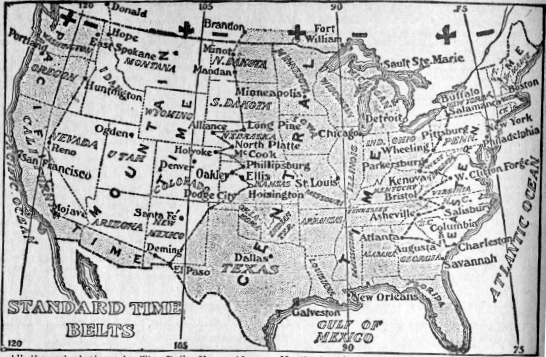Time Zones
 Time zones were determined locally until the coming of railroads. Schedules then became essential, particularly for trains traveling in an east-west direction. In the decade before 1880, the need for standardization became critical and the subject was widely discussed. The United States observed almost 100 conflicting local sun times until the fall of 1883, when a General Time Convention met in Chicago on 11 October and a Southern Time Convention convened in New York on 17 October. As a result, at noon on Sunday, 18 Nov. 1883, four times zones across the nation were established. Most of North Carolina fell into the Eastern Standard Time zone, but the western limit for that zone ran through Asheville at 82 W 33', thereby leaving a portion of western North Carolina in the Central Standard Time zone. This remained the case until 1946, when most of the municipalities in the western counties passed local ordinances changing to Eastern Standard Time. On 28 Sept. 1947 North Carolina adopted Eastern Standard Time statewide.
Time zones were determined locally until the coming of railroads. Schedules then became essential, particularly for trains traveling in an east-west direction. In the decade before 1880, the need for standardization became critical and the subject was widely discussed. The United States observed almost 100 conflicting local sun times until the fall of 1883, when a General Time Convention met in Chicago on 11 October and a Southern Time Convention convened in New York on 17 October. As a result, at noon on Sunday, 18 Nov. 1883, four times zones across the nation were established. Most of North Carolina fell into the Eastern Standard Time zone, but the western limit for that zone ran through Asheville at 82 W 33', thereby leaving a portion of western North Carolina in the Central Standard Time zone. This remained the case until 1946, when most of the municipalities in the western counties passed local ordinances changing to Eastern Standard Time. On 28 Sept. 1947 North Carolina adopted Eastern Standard Time statewide.
During World War I, North Carolina adopted Daylight Time for the periods 31 Mar.-27 Oct. 1918 and 30 Mar.-26 Oct. 1919. Between 1 Aug. 1941 and 9 Feb. 1942, state offices operated on Daylight Time; from 9 Feb. 1942 to 30 Sept. 1945, North Carolina implemented what President Franklin D. Roosevelt called "War Time." From 1946 to 1965 North Carolina did not observe Daylight Time, but since 1966 the state has followed the national schedule.
References:
Doris Chase Doane, Time Changes in the U.S.A. (1981).
U.S. Department of Transportation, Standard Time in the United State: A History of Standard and Daylight Saving Time in the United States and an Analysis of the Related Laws (1970).
Additional Resources:
"Today in History: November 18" American Memory, The Library of Congress. http://memory.loc.gov/ammem/today/nov18.html (accessed September 18, 2012).
"The Times Reports on 'the Day of Two Noons'." New York Times. 18 November 1883. History Matters: The U.S. Survey Course on the Web. George Mason University. http://historymatters.gmu.edu/d/5748/ (accessed September 18, 2012).
Image Credits:
Chicago Daily News. "File:Time zone map of the United States 1913.tif" Daily News Almanac and Directory for 1913. p. 32. Wikipedia.com. http://en.wikipedia.org/w/index.php?title=File:Time_zone_map_of_the_United_States_1913.tif (accessed September 18, 2012).
1 January 2006 | Powell, William S.